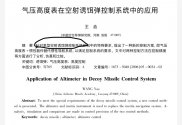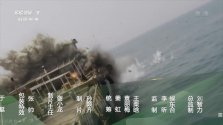You are using an out of date browser. It may not display this or other websites correctly.
You should upgrade or use an alternative browser.
You should upgrade or use an alternative browser.
PLAN Anti-ship/surface missiles
- Thread starter tphuang
- Start date
Hah, that's an interesting set of requirements.
Basically, you've described a sort of sino-JSM - thou that thing isn't exactly optimal for J-35 bay, and in terms of shape it'll be an interesting choice between maneuverability, volume and stealth. (Kh-59mk2 immediately comes to mind when you want to squeeze every ounce of weight from a rectangular bay - but that thing, in turn, isn't really an ASCM)
J-15B is hardly a limiting factor here: this plane may very well end up at around freaking ~19/39t empty/MTOW, i.e. it will in principle fly with 4 LRASM-type weapons to a very significant range, especially if launched with a catapult.
In the end, one of more important aspects of heavy ASCM is the ability to reliably take modern surface combatants out of the picture in one hit. When your second stablemate is a full-size heavy fighter, I don't think it's a problem.
J-15B carrying 4 LRASM sized missiles would be pretty unrealistic imo. We haven't really seen PLAN try to push their fighter jets to carry close to the theoretical limit of their payload. 4 LRASM + 2 PL-15 + 2 PL-10 + ECM pods would probably be 6t of payload. That's a lot.
If they are really going to push it to that level, I'd much rather see them carry 4 sino-JSM and receive the additional weight for multiple MALD and such. It would be nice if they develop miniature MALD that they carry multiple per hard point. USN is extremely good at tracking and engaging all sort of targets. Saturation attack with real missiles and decoys is the way to go imo.
If we compare LRASM to something like JSM (let's assuming similar signature and passive tracking/low emission seeker/communication)
Former would have greater warhead and range
Latter would be more maneuverable and compact.
At this point, I'd favor the latter from my fighter jet over the former, because I think the latter gives you more operational flexibility. YJ-83K are not bad. They are just too large (with fins) to ever be carried internally. They are also not stealthy at all. It's because PLAN also has YJ-18s and ASBM that I think it's ok if the air launch missiles does not have a large warhead. Having a lot of subsonic missiles coming through at the same time as supersonic/hypersonic missiles can overwhelm defense.
My opinion is PLA had built some MALD but chose to hide it.J-15B carrying 4 LRASM sized missiles would be pretty unrealistic imo. We haven't really seen PLAN try to push their fighter jets to carry close to the theoretical limit of their payload. 4 LRASM + 2 PL-15 + 2 PL-10 + ECM pods would probably be 6t of payload. That's a lot.
If they are really going to push it to that level, I'd much rather see them carry 4 sino-JSM and receive the additional weight for multiple MALD and such. It would be nice if they develop miniature MALD that they carry multiple per hard point. USN is extremely good at tracking and engaging all sort of targets. Saturation attack with real missiles and decoys is the way to go imo.
If we compare LRASM to something like JSM (let's assuming similar signature and passive tracking/low emission seeker/communication)
Former would have greater warhead and range
Latter would be more maneuverable and compact.
At this point, I'd favor the latter from my fighter jet over the former, because I think the latter gives you more operational flexibility. YJ-83K are not bad. They are just too large (with fins) to ever be carried internally. They are also not stealthy at all. It's because PLAN also has YJ-18s and ASBM that I think it's ok if the air launch missiles does not have a large warhead. Having a lot of subsonic missiles coming through at the same time as supersonic/hypersonic missiles can overwhelm defense.
In general “某型” implies something in service and it’s a paper published in 2005.

Last edited:
It's worth noting that USAF and USN themselves go for both. Sure, LRASMs are rare "silver bullets" for unusual targets, but still they're worth it.At this point, I'd favor the latter from my fighter jet over the former, because I think the latter gives you more operational flexibility. YJ-83K are not bad. They are just too large (with fins) to ever be carried internally. They are also not stealthy at all. It's because PLAN also has YJ-18s and ASBM that I think it's ok if the air launch missiles does not have a large warhead. Having a lot of subsonic missiles coming through at the same time as supersonic/hypersonic missiles can overwhelm defense.
125 kg warhead is a ~100kg bomb, which, going by ww2 experience, tended to harm main surface combatants. 500kg bombs tended to criple or outright sink them.
With a peer enemy, you often won't get another chance. The opportunity cost may be immense.
Furthermore, while there are almost no modern armoured combat ships(Kirovs are friendly anyways), carriers and LHAs are still here.
Leaving aircraft with only bombs to finish them off may be less than desirable.
If you're forming a deckload strike against a high-tier surface force, no one forces you to do self-escorts and "do it all" 4-ships.J-15B carrying 4 LRASM sized missiles would be pretty unrealistic imo. We haven't really seen PLAN try to push their fighter jets to carry close to the theoretical limit of their payload. 4 LRASM + 2 PL-15 + 2 PL-10 + ECM pods would probably be 6t of payload. That's a lot.
Strike package is strike package, escort is escort, AD suppression is AD suppression. Multirole is an opportunity, not an obligation.
Flankers can be viably loaded in high-end combat to very high loads, higher than F-18s and F-35s, likely higher than future J-35s, too. When on 003, it's your right and your opportunity to use it.
From this source LRASM is a high end weapon not a low end, volume based weapon at $4 million USD each.
Tomahawk is already $1.5 million USD and is slow, non stealthy.
As per an old CSBA paper, an antiship variant adds $2 Million to the cost of the equivalent land-attack missile.
My opinion is PLA had built some MALD but chose to hide it.
In general “某型” implies something in service and it’s a paper published in 2005.
Yeah, I see MALDs as a no-brainer to have
It’s natural to think about ASBM launching from a container ship after watching how LM-11 launched from a barge with some simple and portable facilities. Even TEL is not necessary. Missiles can be pretended to containers and the ship can reach Europe, San Diego, New York, or any where US CVNs can be.USN assumption for SM-6 deployment in civilian ships is that they can be hidden until attack, the same logic for any Chinese civilian ships with AShM. China has a much better position because 1) their missiles are more lethal then SM-6 and has a potential to sunk all US CVNs with 10 civilian ships in D-day 2) they operate much more civilian ships than US.
Air carriers are out of date.
If you hit an escort ship with a 150 kg warhead, that escort will at least be temporarily out of action and unable to defend rest of the fleet. The overall air defense capability of the fleet declines by as much as if you hit with a 450 kg warhead. That escort will be unable to defend itself from something like YJ-18. If we look at the center prize, neither a 150 kg or a 450 kg at subsonic speed going parallel to water is going to be able to take a carrier or LHA out of action. ASBM or HGV is a big deal because they are coming straight down at mach5+ with a large warhead. Anything smaller than a super carrier is likely going down. Even a carrier would be crippled after getting hit by one of those. Definitely losing all of its air wing and out of that battle.It's worth noting that USAF and USN themselves go for both. Sure, LRASMs are rare "silver bullets" for unusual targets, but still they're worth it.
125 kg warhead is a ~100kg bomb, which, going by ww2 experience, tended to harm main surface combatants. 500kg bombs tended to criple or outright sink them.
With a peer enemy, you often won't get another chance. The opportunity cost may be immense.
Furthermore, while there are almost no modern armoured combat ships(Kirovs are friendly anyways), carriers and LHAs are still here.
Leaving aircraft with only bombs to finish them off may be less than desirable.
If you can carry the same number of large missile and smaller missile without losing combat capabilities elsewhere, then carrying the larger missiles is better. I just don't see that being the case here. I would want PLAN air wing to carry more fuel and/or have better maneuverability from lower payload. I also think it's important to be able to carry AShM inside J-35 weapon bay so that they can have stealth advantage over opposing aircraft.
Carrier air wing resource is finite. Let's say you start with an on board air wing of 30 J-35s and 12 J-15s on a 003. Not all of them will be available for action due to maintenance requirement. Let's say you can operate sorties on 2/3 of them, so about 20 J-35s and 8 J-15s. Out of that, you probably want 3 or 4 J-15s for buddy to buddy refueling. Maybe you want 4 dedicated EW version of J-35s to be in the air. So, now you are left with 16 J-35s and 4 J-15s. That's a capable air wing, but they have finite air time. It would be one thing if PLAN does not have surface combatant, but they do. Those 850mm UVLS allows them to carry more fire power on surface fleet than any Western surface combatants. I personally think the air wing would be better served to stay up there to intercept penetrating opposing aircraft, providing targeting data for its surface combatants, tracking incoming missiles and maybe go after force multipliers on the other side.If you're forming a deckload strike against a high-tier surface force, no one forces you to do self-escorts and "do it all" 4-ships.
Strike package is strike package, escort is escort, AD suppression is AD suppression. Multirole is an opportunity, not an obligation.
Flankers can be viably loaded in high-end combat to very high loads, higher than F-18s and F-35s, likely higher than future J-35s, too. When on 003, it's your right and your opportunity to use it.
In light of the recent photos of possible ASBM or HGV or HCMs, I got curious enough to see what US Navy is doing about it because I read some interesting stuff like this
I found the entire confidence in there to be quite puzzling, so I took some further look into it. Now, SM-3 is the primary interceptor for US Navy against long range ballistic missiles like ICBMs, but they are purchased in small numbers and probably available in small numbers also. It seems like SM-6 is the main interceptors against IRBM with US Navy. It does seem like SM-6 had some successful tests against ballistic missiles. Although, the most recent one with 4 SM-6s against 2 SRBM may not have destroyed both of them
Which brought me to look at HGVs, which are a lot harder for AAW ships to track and intercept, since they are not following the traditional ballistic flight path.
Looking at the current USN plan on how they intend to deal with HGV, it doesn't really ring a lot of confidence since they are mostly dependent on satellites to detect HGVs at launch or earlier part of the flight. It seems like these solutions would be in a lot of trouble if anti-satellite weapons or really aggressive jamming or countermeasures are used against the surveying satellites or if they find ways to decrease HGV's general detection from satellite (maybe some kind of materials that would be harder to identify). Once you get to the terminal phase, these missiles get a lot harder to intercept.
And there is also the scenario of hypersonic anti-ship cruise missiles, which would seem like the hardest to track and to intercept.
It definitely seems like we have this race going where the anti-ship missile technologies are improving and becoming harder to track and intercept, but the defense technologies are also improving. ASBM was probably fully ready 5 years ago. The goalpost has been moving pretty rapidly since. I'm not too sure why the US naval intel head is hoping China would spend more money in this area. This seems like the best way for them to overwhelm carrier group air defense network. It is quite different to be handling a few ASBM vs handling 50 anti-ship missiles of different hypersonic and supersonic variety. PLAN/PLAAF inducting a large number of these types of missiles and lowering their production costs is pretty much bad news for everyone else.
I found the entire confidence in there to be quite puzzling, so I took some further look into it. Now, SM-3 is the primary interceptor for US Navy against long range ballistic missiles like ICBMs, but they are purchased in small numbers and probably available in small numbers also. It seems like SM-6 is the main interceptors against IRBM with US Navy. It does seem like SM-6 had some successful tests against ballistic missiles. Although, the most recent one with 4 SM-6s against 2 SRBM may not have destroyed both of them
Which brought me to look at HGVs, which are a lot harder for AAW ships to track and intercept, since they are not following the traditional ballistic flight path.
Looking at the current USN plan on how they intend to deal with HGV, it doesn't really ring a lot of confidence since they are mostly dependent on satellites to detect HGVs at launch or earlier part of the flight. It seems like these solutions would be in a lot of trouble if anti-satellite weapons or really aggressive jamming or countermeasures are used against the surveying satellites or if they find ways to decrease HGV's general detection from satellite (maybe some kind of materials that would be harder to identify). Once you get to the terminal phase, these missiles get a lot harder to intercept.
And there is also the scenario of hypersonic anti-ship cruise missiles, which would seem like the hardest to track and to intercept.
It definitely seems like we have this race going where the anti-ship missile technologies are improving and becoming harder to track and intercept, but the defense technologies are also improving. ASBM was probably fully ready 5 years ago. The goalpost has been moving pretty rapidly since. I'm not too sure why the US naval intel head is hoping China would spend more money in this area. This seems like the best way for them to overwhelm carrier group air defense network. It is quite different to be handling a few ASBM vs handling 50 anti-ship missiles of different hypersonic and supersonic variety. PLAN/PLAAF inducting a large number of these types of missiles and lowering their production costs is pretty much bad news for everyone else.


